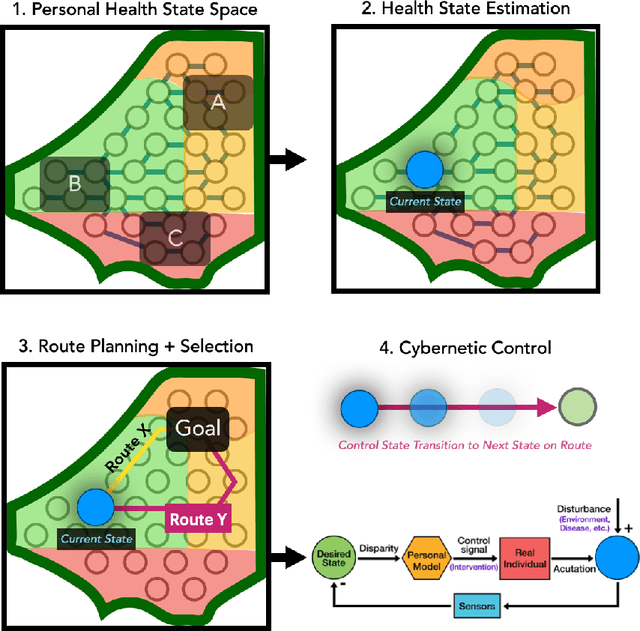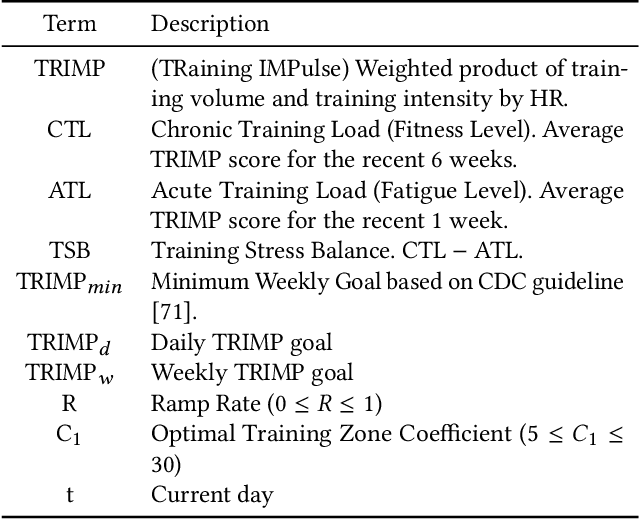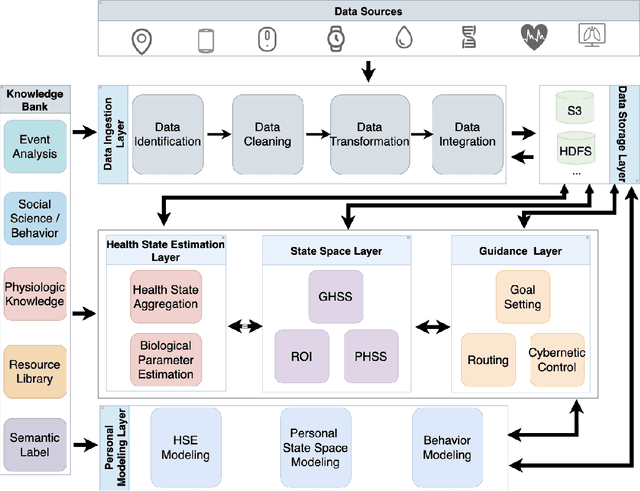Nitish Nag
Towards Integrative Multi-Modal Personal Health Navigation Systems: Framework and Application
Nov 16, 2021



Abstract:It is well understood that an individual's health trajectory is influenced by choices made in each moment, such as from lifestyle or medical decisions. With the advent of modern sensing technologies, individuals have more data and information about themselves than any other time in history. How can we use this data to make the best decisions to keep the health state optimal? We propose a generalized Personal Health Navigation (PHN) framework. PHN takes individuals towards their personal health goals through a system which perpetually digests data streams, estimates current health status, computes the best route through intermediate states utilizing personal models, and guides the best inputs that carry a user towards their goal. In addition to describing the general framework, we test the PHN system in two experiments within the field of cardiology. First, we prospectively test a knowledge-infused cardiovascular PHN system with a pilot clinical trial of 41 users. Second, we build a data-driven personalized model on cardiovascular exercise response variability on a smartwatch data-set of 33,269 real-world users. We conclude with critical challenges in health computing for PHN systems that require deep future investigation.
Health State Estimation
Mar 16, 2020Abstract:Life's most valuable asset is health. Continuously understanding the state of our health and modeling how it evolves is essential if we wish to improve it. Given the opportunity that people live with more data about their life today than any other time in history, the challenge rests in interweaving this data with the growing body of knowledge to compute and model the health state of an individual continually. This dissertation presents an approach to build a personal model and dynamically estimate the health state of an individual by fusing multi-modal data and domain knowledge. The system is stitched together from four essential abstraction elements: 1. the events in our life, 2. the layers of our biological systems (from molecular to an organism), 3. the functional utilities that arise from biological underpinnings, and 4. how we interact with these utilities in the reality of daily life. Connecting these four elements via graph network blocks forms the backbone by which we instantiate a digital twin of an individual. Edges and nodes in this graph structure are then regularly updated with learning techniques as data is continuously digested. Experiments demonstrate the use of dense and heterogeneous real-world data from a variety of personal and environmental sensors to monitor individual cardiovascular health state. State estimation and individual modeling is the fundamental basis to depart from disease-oriented approaches to a total health continuum paradigm. Precision in predicting health requires understanding state trajectory. By encasing this estimation within a navigational approach, a systematic guidance framework can plan actions to transition a current state towards a desired one. This work concludes by presenting this framework of combining the health state and personal graph model to perpetually plan and assist us in living life towards our goals.
Personalized Taste and Cuisine Preference Modeling via Images
Feb 26, 2020



Abstract:With the exponential growth in the usage of social media to share live updates about life, taking pictures has become an unavoidable phenomenon. Individuals unknowingly create a unique knowledge base with these images. The food images, in particular, are of interest as they contain a plethora of information. From the image metadata and using computer vision tools, we can extract distinct insights for each user to build a personal profile. Using the underlying connection between cuisines and their inherent tastes, we attempt to develop such a profile for an individual based solely on the images of his food. Our study provides insights about an individual's inclination towards particular cuisines. Interpreting these insights can lead to the development of a more precise recommendation system. Such a system would avoid the generic approach in favor of a personalized recommendation system.
Surface Type Estimation from GPS Tracked Bicycle Activities
Sep 25, 2018



Abstract:Road conditions affect both machine and human powered modes of transportation. In the case of human powered transportation, poor road conditions increase the work for the individual to travel. Previous estimates for these parameters have used computationally expensive analysis of satellite images. In this work, we use a computationally inexpensive and simple method by using only GPS data from a human powered cyclist. By estimating if the road taken by the user has high or low variations in their directional vector, we classify if the user is on a paved road or on an unpaved trail. In order to do this, three methods were adopted, changes in frequency of the direction of slope in a given path segment, fitting segments of the path, and finding the first derivative and the number of points of zero crossings of each segment. Machine learning models such as support vector machines, K-nearest neighbors, and decision trees were used for the classification of the path. We show in our methods, the decision trees performed the best with an accuracy of 86\%. Estimation of the type of surface can be used for many applications such as understanding rolling resistance for power estimation estimation or building exercise recommendation systems by user profiling as described in detail in the paper.
Cross-Modal Health State Estimation
Aug 23, 2018



Abstract:Individuals create and consume more diverse data about themselves today than any time in history. Sources of this data include wearable devices, images, social media, geospatial information and more. A tremendous opportunity rests within cross-modal data analysis that leverages existing domain knowledge methods to understand and guide human health. Especially in chronic diseases, current medical practice uses a combination of sparse hospital based biological metrics (blood tests, expensive imaging, etc.) to understand the evolving health status of an individual. Future health systems must integrate data created at the individual level to better understand health status perpetually, especially in a cybernetic framework. In this work we fuse multiple user created and open source data streams along with established biomedical domain knowledge to give two types of quantitative state estimates of cardiovascular health. First, we use wearable devices to calculate cardiorespiratory fitness (CRF), a known quantitative leading predictor of heart disease which is not routinely collected in clinical settings. Second, we estimate inherent genetic traits, living environmental risks, circadian rhythm, and biological metrics from a diverse dataset. Our experimental results on 24 subjects demonstrate how multi-modal data can provide personalized health insight. Understanding the dynamic nature of health status will pave the way for better health based recommendation engines, better clinical decision making and positive lifestyle changes.
* Accepted to ACM Multimedia 2018 Conference - Brave New Ideas, Seoul, Korea, ACM ISBN 978-1-4503-5665-7/18/10
 Add to Chrome
Add to Chrome Add to Firefox
Add to Firefox Add to Edge
Add to Edge